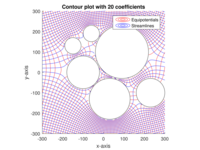Analytic element method

Analytic element method is like playing with toy boats in a bathtub to understand how water moves. Imagine you have a toy boat in a bathtub filled with water, and you pour some liquid soap on one end. You would notice that the soap creates a swirl that moves the boat. That's because the soap changes the movement of the water around it, making the boat move in a particular direction.
The analytic element method works in a similar way, but instead of soap and water, it deals with mathematical formulas and the movement of fluids like groundwater, air or temperature. The method uses simple shapes called analytic elements, which are represented by mathematical functions.
These elements represent things like wells, rivers, or buildings that affect how the fluid moves around them. Analysts can create models of the way fluid moves by combining these simple elements with known mathematical equations.
For instance, if we wanted to know how water moves in a particular area where there is a well, we would use the analytic element method to create a model of the groundwater movement. We would represent the well using a simple mathematical formula that describes how water flows in and out of the well, and we would combine that with other mathematical equations that describe how water moves through the soil.
Using the model, we could predict how water will move around the well under different conditions. We could also use the same method to predict how the well will affect the groundwater levels in nearby areas.
Just like playing with toy boats in a bathtub, the analytic element method allows us to experiment with different conditions and see how the fluid moves in response. It's a powerful tool that helps us understand the complex behavior of fluids and make better decisions about how to manage and protect natural resources.
The analytic element method works in a similar way, but instead of soap and water, it deals with mathematical formulas and the movement of fluids like groundwater, air or temperature. The method uses simple shapes called analytic elements, which are represented by mathematical functions.
These elements represent things like wells, rivers, or buildings that affect how the fluid moves around them. Analysts can create models of the way fluid moves by combining these simple elements with known mathematical equations.
For instance, if we wanted to know how water moves in a particular area where there is a well, we would use the analytic element method to create a model of the groundwater movement. We would represent the well using a simple mathematical formula that describes how water flows in and out of the well, and we would combine that with other mathematical equations that describe how water moves through the soil.
Using the model, we could predict how water will move around the well under different conditions. We could also use the same method to predict how the well will affect the groundwater levels in nearby areas.
Just like playing with toy boats in a bathtub, the analytic element method allows us to experiment with different conditions and see how the fluid moves in response. It's a powerful tool that helps us understand the complex behavior of fluids and make better decisions about how to manage and protect natural resources.
Related topics others have asked about:
